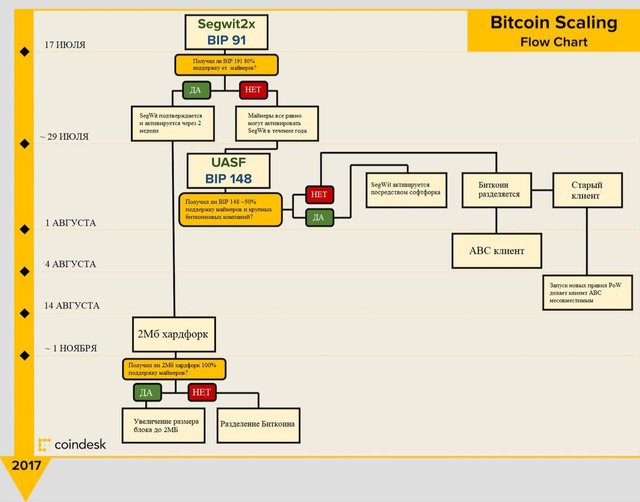An fixation BIP 91 in the Bitcoin network.

The update of the bitlock protocol BIP 91 was successfully activated on the night of July 21. More than 90% of the hashreid supported the decision, which means that after the vote Segregated Witness (SegWit) activation should take place, therefore, the key date on August 1 for voting on BIP 148 also loses its relevance.
Nevertheless, the activation of SegWit has not yet occurred and has not become technically closer.
BIP 91 is the version of the implementation of the SegWit2x agreement, which was supported by most of the major bitcom companies and mining pools. Its distinctive feature is that the offer is compatible with BIP 148 (UASF), which also presupposes the activation of SegWit.
In order to fix BIP 91, it was necessary that the miners signal for 56 hours support of this solution via the signal bit (bit 4), while generating the following 269 of 336 blocks. The last of the 269 was generated tonight.
However, SegWit will be activated only if during the second stage of activation of BIP 91, 95% of the hashing capacity will signal the support with the help of a bit bit (bit 1) during the 2 week period of the complexity adjustment.
In the event that during this period most of the miners support BIP 91, their capacities should begin to control the longest valid chain that all nodes will accept. And since this chain consists of SegWit-blocks, accordingly, the SegWit protocol itself will be activated.
However, there are still no guarantees that the proposal will be activated.

Segwit2x: options for the development of the event.
So, despite all doubts and pessimistic forecasts, SegWit2X is on the verge of activation. Considering how the BIP 91 code is written, an 80% threshold must be reached within 336 blocks. But this is not just any consecutive period of 336 blocks. There is a set of 'windows' between recalculations of complexity on the network in which the miners can express their support, which means that 269 of the consecutive 336 blocks in this period should signal the support of SegWit2X with 'bit 4' in the header of the block. And the current period of voting can already be called decisive.
Approximately 4 hours after the publication of this article, the first voting period of 336 blocks will end, which will fix the support by the miners of this update. As more than 83% of votes have already been collected, there can be no doubt about it. In the next period, also from 336 blocks (1/6 of the complexity recalculation period, on average 2 days and 8 hours), there will be a vote on activation. If it also collects more than 80% of the votes of the miners, then the three-year discussions about Bitcoin scaling can be considered complete. The hope for this momentous event, which is becoming more and more likely, in one day raised the rate of bitcoin by more than 400 dollars, and it exceeded $ 2750 for the first time in a month.
Voting for SegWit2X
If everything goes according to plan, then with the following recalculation of complexity Bitcoin will be updated to support SegWit with the condition of carrying out a three-month hardfork with increasing block size. Now the actual support for SegWit2X, according to Coin.dance data for the last day, exceeds 90%. In fact, SegWit2X is already voting for all large pools, with the exception of Slush, so the likelihood that the vote will fail is very small.
If there is not even a vote in the next period, there will be two more to avoid a conflict in the network. What could happen if something unexpected happened to the camp of the miners, which could change plans and disrupt the voting? This can be caused, for example, by the detection of a critical vulnerability in the BTC1 client code responsible for the implementation of SegWit2X.
Here are a few options for developing Bitcoin in case activation of SegWit2X does not occur before August 1:
Descriptions of upgrade options
Segregated Witness (SegWit): A proposal put forward by the Bitcoin Core team in 2015. SegWit aims to increase network bandwidth by separating signatures from the contents of transactions and solving the problem of the plasticity of transactions through softfocus. BIP 141 requires 95% support for upgrades for two weeks (one period of complexity recalculation).
SegWit2x: The proposal was adopted in New York in May, supported by miners and companies, aimed at activating SegWit via softfock and increasing the block size through hardfork in three months.
BIP 91 (BTC1): The implementation mechanism of SegWit2X, created by James Hilliard (James Hilliard) - engineer Bitmain Warranty. BIP 91 should fix the SegWit update via SegWit2x before August 1, making it compatible with BIP 148. BIP 91 requires only 80% of support for bitcoin miners and a six-time shorter voting period than BIP141.
BIP 148: A mechanism for modifying Bitcoin called 'user-activated softswitch (UASF)'. In fact, it is a hard-core, since if the condition is not fulfilled (activation of SegWit through BIP141 before August 1), it will begin to reject incompatible blocks, which will lead to the separation of the network into two competing lock-ups.
Bitcoin ABC (UAHF): Bitcoin client version, which activates the dynamic block size. This idea was first proposed by Chinese miners as a response to the UASF concept. If the Bitcoin is split due to UASF, the Bitcoin ABC client will be launched in the alternate network, which may lead to the creation of the third branch of the blocking system.
Source: from the author